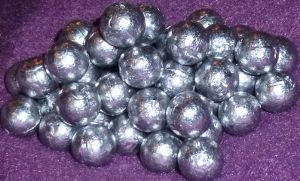The chemical element lead is classed as an other metal. It has been known since ancient times. Its discoverer and discovery date are unknown.

Data Zone
| Classification: | Lead is an ‘other metal’ |
| Color: | bluish gray |
| Atomic weight: | 207.2 |
| State: | solid |
| Melting point: | 327.46 oC, 600.61 K |
| Boiling point: | 1750 oC, 2023 K |
| Electrons: | 82 |
| Protons: | 82 |
| Neutrons in most abundant isotope: | 126 |
| Electron shells: | 2,8,18,32,18,4 |
| Electron configuration: | [Xe] 4f14 5d10 6s2 6p2 |
| Density @ 20oC: | 11.34 g/cm3 |
Reactions, Compounds, Radii, Conductivities
| Atomic volume: | 18.17 cm3/mol |
| Structure: | fcc: face-centered cubic |
| Hardness: | 1.5 mohs |
| Specific heat capacity | 0.13 J g-1 K-1 |
| Heat of fusion | 4.77 kJ mol-1 |
| Heat of atomization | 196 kJ mol-1 |
| Heat of vaporization | 177.9 kJ mol-1 |
| 1st ionization energy | 715.6 kJ mol-1 |
| 2nd ionization energy | 1450.5 kJ mol-1 |
| 3rd ionization energy | 3081.5 kJ mol-1 |
| Electron affinity | 35.1 kJ mol-1 |
| Minimum oxidation number | -4 |
| Min. common oxidation no. | 0 |
| Maximum oxidation number | 4 |
| Max. common oxidation no. | 4 |
| Electronegativity (Pauling Scale) | 2.33 |
| Polarizability volume | 6.8 Å3 |
| Reaction with air | mild, w/ht ⇒ PbO |
| Reaction with 15 M HNO3 | mild, ⇒ NOx, Pb(NO3)2 |
| Reaction with 6 M HCl | none |
| Reaction with 6 M NaOH | – |
| Oxide(s) | PbO (litharge), PbO2, Pb2O3, Pb3O4 |
| Hydride(s) | PbH4 |
| Chloride(s) | PbCl2 & PbCl4 |
| Atomic radius | 180 pm |
| Ionic radius (1+ ion) | – |
| Ionic radius (2+ ion) | 133 pm |
| Ionic radius (3+ ion) | – |
| Ionic radius (1- ion) | – |
| Ionic radius (2- ion) | – |
| Ionic radius (3- ion) | – |
| Thermal conductivity | 35.3 W m-1 K-1 |
| Electrical conductivity | 4.8 x 106 S m-1 |
| Freezing/Melting point: | 327.46 oC, 600.61 K |
Discovery of Lead
Lead has been known since ancient times. We do not know who discovered it.
Its ores are widely distributed and it has a low melting point so it is easily smelted.
It was used in antiquity to make statues, coins, utensils and writing tablets. The Romans also used lead for plumbing.
The Romans called lead ‘plumbum nigrum’ meaning black lead to differentiate it from ‘plumbum album’ meaning white lead. We now call ‘white lead’ tin. Tin sits directly above lead in the periodic table.
Lead’s chemical symbol is Pb, which comes from its Latin name. Our name for the element comes from the Anglo-Saxon word for the metal, ‘lead’.
The image below shows shiny, untarnished lead balls.



Nasa: A cargo tag made of lead was unearthed during excavation of the original colony at Jamestown, Virginia. It is believed to have made the trip from England in 1611.
Appearance and Characteristics
Harmful effects:
Lead and its compounds are poisonous.
Characteristics:
Lead is a bluish-gray, soft, dense metal that has a bright luster when freshly cut.
It tarnishes slowly in moist air to form a dull gray coating.
The metal is highly ductile and malleable.
Lead is extremely resistant to corrosion and is a poor conductor of electricity.
Uses of Lead
Large quantities of lead, both as the metal and as the dioxide, are used in storage batteries.
Lead is also used in cable covering, as ammunition, as electrodes, in solder and as roofing material.
The metal is used as shielding from radiation, e.g. in x-ray rooms and nuclear reactors.
Lead oxide is also used in the manufacture of fine crystal glass.
Historically, lead was used in plumbing.
Tetraethyl lead was used as an anti-knock agent in petrol, and as an additive in paints. These uses have been reduced recently because of environmental concerns about cumulative lead poisoning.
Abundance and Isotopes
Abundance earth’s crust: 14 parts per million by weight, 1 part per million by moles
Abundance solar system: 10 parts per billion by weight, 70 parts per trillion by moles
Cost, pure: $2.45 per 100g
Cost, bulk: $0.02 per 100g
Source: Lead rarely occurs naturally in nature and is can be found in ores, mainly with copper, zinc and silver. The principal lead mineral is lead sulfide (galena, PbS). Other common minerals are cerussite (lead carbonate, PbCO3) and anglesite (lead sulfate, PbSO4). Lead is refined from galena (PbS) by heating. A large amount of lead is also recovered from recycling.
Isotopes: Lead has 35 isotopes whose half-lives are known, mass numbers 181 to 215. Naturally occurring lead is a mixture of four isotopes and they are found in the percentages shown: 204Pb (1.4%), 206Pb (24.1%), 207Pb (22.1%) and 208Pb (52.3%).

References
Cite this Page
For online linking, please copy and paste one of the following:
<a href="https://www.chemicool.com/elements/lead.html">Lead</a>
or
<a href="https://www.chemicool.com/elements/lead.html">Lead Element Facts</a>
To cite this page in an academic document, please use the following MLA compliant citation:
"Lead." Chemicool Periodic Table. Chemicool.com. 29 Dec. 2012. Web. <https://www.chemicool.com/elements/lead.html>.